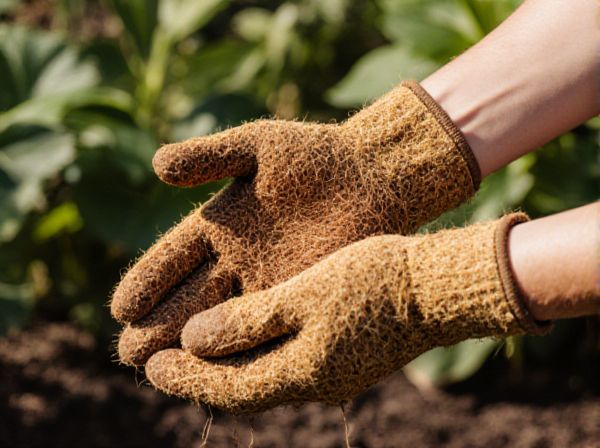
Coco Coir vs Perlite Illustration
Coco coir offers excellent water retention and aeration, making it ideal for hydroponic systems requiring consistent moisture levels. Perlite provides superior drainage and oxygen flow to roots, preventing root rot in tightly packed growing media. Choosing between coco coir and perlite depends on the crop's water needs and the desired balance of moisture retention versus aeration in the hydroponic setup.
Table of Comparison
| Feature | Coco Coir | Perlite |
|---|---|---|
| Material | Natural fiber from coconut husks | Volcanic glass, expanded by heat |
| Water Retention | High moisture retention | Low water retention |
| Aeration | Moderate aeration | Excellent aeration |
| pH Level | Neutral to slightly acidic (5.5-6.8) | Neutral to slightly alkaline (7.0-8.5) |
| Reusability | Reusable after thorough washing | Reusable, maintains structure well |
| Cost | Moderate, sustainable option | Generally lower cost |
| Environmental Impact | Biodegradable, eco-friendly | Non-biodegradable, inert |
| Best Use | Water-loving plants, moisture retention | Root aeration, preventing compaction |
Introduction to Hydroponic Growing Mediums
Coco coir and perlite are two popular hydroponic growing mediums valued for their unique physical properties and nutrient retention capabilities. Coco coir, derived from coconut husks, offers excellent water retention and aeration, making it ideal for promoting root health in hydroponic systems. Perlite, a volcanic glass expanded into lightweight granules, provides superior drainage and airflow but requires careful nutrient management due to its inert nature.
What is Coco Coir?
Coco coir is a natural growing medium derived from the husk of coconut shells, known for its excellent water retention and aeration properties. It provides a sustainable and renewable alternative to traditional soil, rich in lignin and cellulose which supports healthy root development. Popular in hydroponic systems, coco coir enhances moisture management while promoting beneficial microbial activity for robust plant growth.
What is Perlite?
Perlite is a lightweight, volcanic glass material commonly used in hydroponic systems as a growing medium due to its excellent aeration and drainage properties. It is formed by heating volcanic rock to high temperatures, causing it to expand and become porous, which helps prevent root rot and promotes healthy plant growth. Unlike coco coir, perlite does not retain water but provides superior oxygen flow to roots, making it ideal for hydroponic setups requiring well-drained substrates.
Key Differences Between Coco Coir and Perlite
Coco coir is an organic growing medium derived from coconut husks, known for its excellent water retention and aeration, whereas perlite is an inorganic volcanic glass that enhances drainage and prevents soil compaction. Coco coir retains nutrients and moisture longer, making it ideal for moisture-loving plants, while perlite improves oxygen availability to roots by promoting drainage and reducing water retention. The pH level of coco coir typically ranges from 5.5 to 6.8, favoring slightly acidic conditions, in contrast to perlite's neutral pH around 7.0, influencing nutrient availability and root health.
Water Retention: Coco Coir vs Perlite
Coco coir exhibits superior water retention capabilities compared to perlite, holding up to eight times its weight in water, which ensures consistent moisture availability for hydroponic roots. In contrast, perlite's porous structure offers excellent aeration but retains significantly less water, leading to faster drying of the growing medium. This difference makes coco coir more suitable for crops requiring stable hydration, while perlite benefits plants needing optimal oxygen circulation around the roots.
Aeration and Drainage Comparison
Coco coir offers excellent water retention and moderate aeration, creating a balanced environment for root growth, while perlite provides superior aeration due to its porous structure but retains less moisture. The drainage capacity of perlite outperforms coco coir, preventing waterlogging and promoting oxygen access to roots, which enhances nutrient uptake and plant health. Optimal hydroponic systems often combine coco coir and perlite to leverage the water-holding benefits of coco coir with the enhanced aeration and drainage of perlite.
Nutrient Retention and Release
Coco coir offers superior nutrient retention and gradual release due to its high cation-exchange capacity, enabling plants to absorb essential minerals efficiently over time. Perlite, with its inert and porous structure, provides excellent aeration but lacks nutrient-holding abilities, requiring more frequent nutrient supplementation in hydroponic systems. Optimal hydroponic growth often combines coco coir's retention qualities with perlite's drainage benefits for balanced nutrient delivery and root oxygenation.
Sustainability and Environmental Impact
Coco coir is a renewable resource derived from coconut husks, offering excellent water retention and biodegradability, which makes it a more sustainable choice compared to perlite. Perlite, a volcanic glass expanded through heating, is non-biodegradable and requires significant energy for production, contributing to a larger carbon footprint. The environmental impact of coco coir is lower due to its organic origin and ability to be composted, while perlite disposal poses challenges as it persists in soil and landfills.
Cost Analysis: Coco Coir vs Perlite
Coco coir offers a cost-effective alternative to perlite with a lower price per liter and superior water retention properties, making it ideal for reducing irrigation frequency. Perlite, while more expensive and less efficient in water retention, provides excellent aeration and drainage, crucial for certain hydroponic crops. The choice between coco coir and perlite should consider not only the initial cost but also long-term benefits like reduced water usage and improved root health.
Best Uses for Coco Coir and Perlite in Hydroponics
Coco coir excels in hydroponic systems that require high water retention and aeration, making it ideal for nurturing seedlings and moisture-loving plants such as tomatoes and lettuce. Perlite offers superior drainage and oxygenation, perfect for hydroponic setups targeting plants sensitive to overwatering or requiring fast root oxygen exchange like orchids and succulents. Combining coco coir and perlite enhances root health by balancing moisture retention with aeration, optimizing growth in diverse hydroponic environments.
Coco Coir vs Perlite Infographic

 gardendif.com
gardendif.com